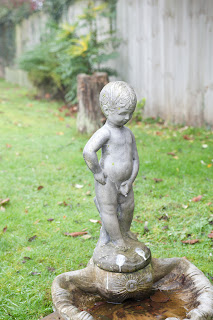Photograph taken in average contrast conditions with a low winter sun coming from the right of the photograph.
Histogram shows a spike to the left indicating blocked shadows. Examination of the image using the Camera Raw conversion (CRc) programme shows that the affected areas are the top left and top right corners of the image. Neither are in critical areas of the image and would probably be cropped out in any finished image.
Same contrast conditions as the preceding image but exposure 1 stop higher.
Histogram shows a good distribution of pixels across the graph and there are no blocked shadows. Although not immediately evident on the histogram examination of the image using CRc reveals some blown highlights on the statue.
Contrast conditions the same as previous two photographs but exposure 1 stop lower.
Histogram shows pixels predominantly to the left indicating that the image is underexposed. Spike on left suggests blocked shadows as would be expected given the exposure time. Again the CRc reveals that that in addition to those revealed in the first image there are some in the grassed area in front of the statue and in the flower bed near to the head. The shadow between the statue's legs is also blocked.
The first three images were taken using automatic exposure bracketing so the lighting conditions are the same for each.
The next three images were taken in low contrast conditions (overcast day) using automatic exposure bracketing.
The first image was taken at 1/125th of a second. The histogram shows a good spread of pixels across the graph indicating a good tonal range. There are no problems with blocked shadows or blown highlights.
Exposure increased by 1 stop.
Marked shift to the right less tonal range as can be seen by comparing the two images. There is a limited amount of blown highlights.
Exposure decreased by 1 stop.
Histogram shows significant shift to the left indicating under exposure and limited tonal range. The are no highlights that extend to the right hand side of the graph. Some blocked out shadows. Examination of the image in CRc shows that these are in the water immediately under the statue.
The next three photographs were taken using off camera flash. The flash unit was fitted with a snoot to provide a concentrated area of light and was placed to the left of the statue at an angle of about 30 degrees. The images were taken separately rather than using AEB but the lighting remained constant because of the use of flash.
The first image was taken at 1/125th of a second. The histogram is almost flat but there are both blocked shadows and blown highlights. The blocked shadows are very limited and relate to the very dark shadow immediately under the statue. There are considerable blown highlights. All the sky at the top of the image is blown out and from head to knee on the left side of the statue.
This image was taken with the exposure increased by one stop. As can be seen there has been a shift to the right and further examination reveals that there are large areas of blown highlights particularly the statue and the sky. Would need a lot of work to improve. Would reject in camera normally.
Histogram suggests good tonal range. There are blocked shadows as can be seen from the spike on the left of the histogram but further examination shows them to be in insignificant areas. There are also some blown highlights but could be easily rectified.
General conclusions - Using the camera histogram offers the opportunity to make judgements of the quality of the photograph almost immediately after the shot is taken by referring to the display on the camera's LCD. It also provides an opportunity to check the camera settings chosen to see if they need some re-setting.
However it does have limitations and care needs to be taken that images are not discarded solely because there is something 'odd' about the histogram. Personally I wait until I have transferred them to the computer and opened them in Camera RAW because the amount of information is so much greater. Furthermore you are able to try out various adjustments that may produce an acceptable or on occasions a very good image.
The ability to combine images in Photoshop e.g. HDR software also should be taken into account before discarding images that have been taken under the same conditions of lighting.


















No comments:
Post a Comment